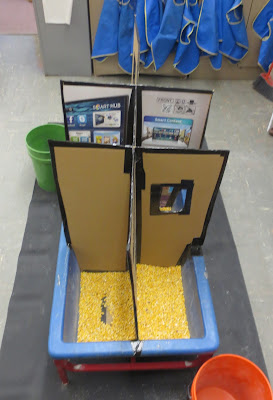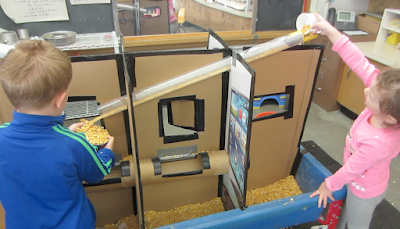I left the cardboard divider up a second week, but I added three different tubes to the construction. First, I embedded a cardboard tube horizontally through the two walls on one side of the divider. The cardboard tube reached over into the second table. Second, I attached a clear plastic tube through the two walls on the same side of the divider as the cardboard tube. The clear plastic tube was set on an incline so it would empty into one of the slots cut in the cardboard tube.
Third, I secured a white PVC tube through the divider on the other side of the installation. That tube was also set on an incline and emptied back into the table into a corner cubicle on that same side.Last week, there was a lot of play through the windows. There was still some of that play, but children definitely changed the focus of their explorations to the tubes.
The tubes, much like the windows, connected children in play across the cardboard walls. Some of the play was as simple as filling your friend's container.
Or was it so simple? For this to work, there had to be ongoing coordination and communication.
One of the big surprises for me was how children combined the tubes and windows in their operations. A child in the video below figured out that he could insert a jello mold into the window so when his friend poured corn down the white tube, it helped fill the container. In the video, watch their joint endeavor.
Filling the jello mold from Thomas Bedard on Vimeo.
The child pouring corn into the tube seemed to keep checking every time he would send some corn down. These three-year-old children definitely worked together, but in a very complicated dance.
Here is another example of how the children modifyied the apparatus by using both a tube and a window. The children in the video figured out how to wedge a dust pan at the end of the clear plastic tube by using the window.
Dust pan modification from Thomas Bedard on Vimeo.
As you can tell, they were very pleased with themselves because they figured out how to divert the corn coming out of the clear plastic tube. The thrill may have been magnified by the fact that the corn was bouncing wildly on the floor.
I have always thought of the sensory table as a blank canvas for me to build apparatuses that I invite the children to explore. After seeing these two videos, I am now thinking that the children use the apparatuses I build as a blank canvas for their own creations.























